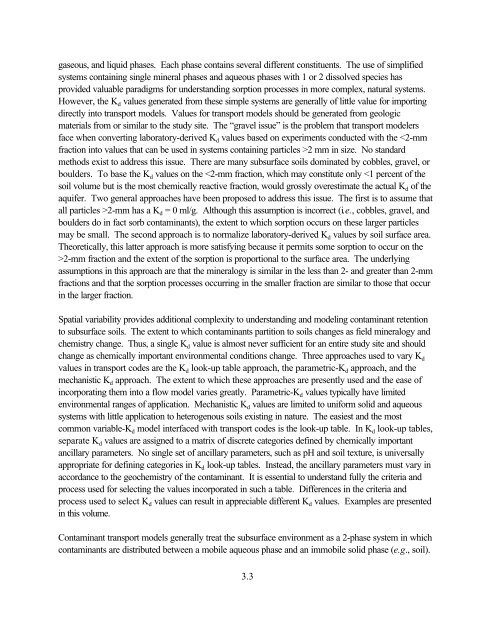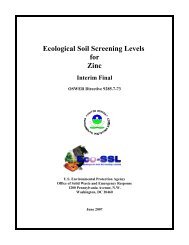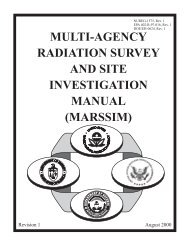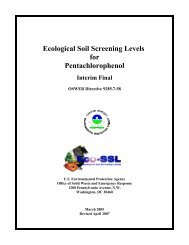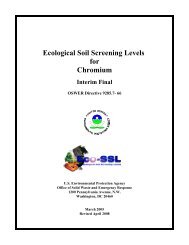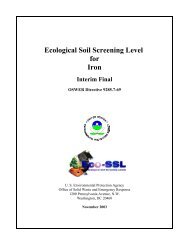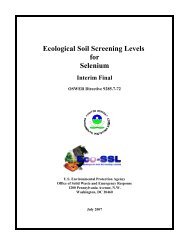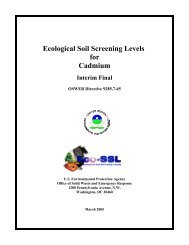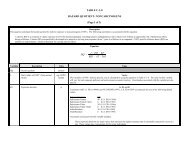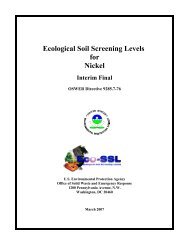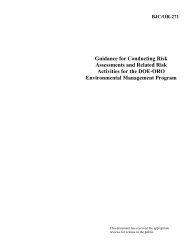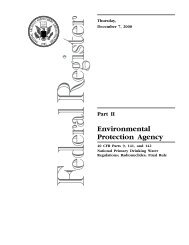Understanding Variation in Partition Coefficient, Kd, Values Volume II
Understanding Variation in Partition Coefficient, Kd, Values Volume II
Understanding Variation in Partition Coefficient, Kd, Values Volume II
Create successful ePaper yourself
Turn your PDF publications into a flip-book with our unique Google optimized e-Paper software.
gaseous, and liquid phases. Each phase conta<strong>in</strong>s several different constituents. The use of simplified<br />
systems conta<strong>in</strong><strong>in</strong>g s<strong>in</strong>gle m<strong>in</strong>eral phases and aqueous phases with 1 or 2 dissolved species has<br />
provided valuable paradigms for understand<strong>in</strong>g sorption processes <strong>in</strong> more complex, natural systems.<br />
However, the K d values generated from these simple systems are generally of little value for import<strong>in</strong>g<br />
directly <strong>in</strong>to transport models. <strong>Values</strong> for transport models should be generated from geologic<br />
materials from or similar to the study site. The “gravel issue” is the problem that transport modelers<br />
face when convert<strong>in</strong>g laboratory-derived K d values based on experiments conducted with the 2 mm <strong>in</strong> size. No standard<br />
methods exist to address this issue. There are many subsurface soils dom<strong>in</strong>ated by cobbles, gravel, or<br />
boulders. To base the K d values on the 2-mm fraction and the extent of the sorption is proportional to the surface area. The underly<strong>in</strong>g<br />
assumptions <strong>in</strong> this approach are that the m<strong>in</strong>eralogy is similar <strong>in</strong> the less than 2- and greater than 2-mm<br />
fractions and that the sorption processes occurr<strong>in</strong>g <strong>in</strong> the smaller fraction are similar to those that occur<br />
<strong>in</strong> the larger fraction.<br />
Spatial variability provides additional complexity to understand<strong>in</strong>g and model<strong>in</strong>g contam<strong>in</strong>ant retention<br />
to subsurface soils. The extent to which contam<strong>in</strong>ants partition to soils changes as field m<strong>in</strong>eralogy and<br />
chemistry change. Thus, a s<strong>in</strong>gle K d value is almost never sufficient for an entire study site and should<br />
change as chemically important environmental conditions change. Three approaches used to vary K d<br />
values <strong>in</strong> transport codes are the K d look-up table approach, the parametric-K d approach, and the<br />
mechanistic K d approach. The extent to which these approaches are presently used and the ease of<br />
<strong>in</strong>corporat<strong>in</strong>g them <strong>in</strong>to a flow model varies greatly. Parametric-K d values typically have limited<br />
environmental ranges of application. Mechanistic K d values are limited to uniform solid and aqueous<br />
systems with little application to heterogenous soils exist<strong>in</strong>g <strong>in</strong> nature. The easiest and the most<br />
common variable-K d model <strong>in</strong>terfaced with transport codes is the look-up table. In K d look-up tables,<br />
separate K d values are assigned to a matrix of discrete categories def<strong>in</strong>ed by chemically important<br />
ancillary parameters. No s<strong>in</strong>gle set of ancillary parameters, such as pH and soil texture, is universally<br />
appropriate for def<strong>in</strong><strong>in</strong>g categories <strong>in</strong> K d look-up tables. Instead, the ancillary parameters must vary <strong>in</strong><br />
accordance to the geochemistry of the contam<strong>in</strong>ant. It is essential to understand fully the criteria and<br />
process used for select<strong>in</strong>g the values <strong>in</strong>corporated <strong>in</strong> such a table. Differences <strong>in</strong> the criteria and<br />
process used to select K d values can result <strong>in</strong> appreciable different K d values. Examples are presented<br />
<strong>in</strong> this volume.<br />
Contam<strong>in</strong>ant transport models generally treat the subsurface environment as a 2-phase system <strong>in</strong> which<br />
contam<strong>in</strong>ants are distributed between a mobile aqueous phase and an immobile solid phase (e.g., soil).<br />
3.3


